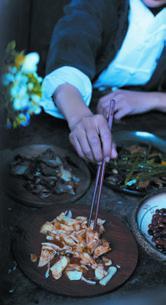Rural Stars,Global Fans
2020-01-07ByLiQing
By Li Qing

In todays global supermarkets, people can easily get condiments from all over the world, such as soy sauce, which has an indispensable role in Chinese kitchens. So it is not strange that today few people know how to make the sauce, especially young people.
However, 29-year-old Li Ziqi is an exception. Li, who lives in a village in Sichuan Province in southwest China, recently uploaded a video to YouTube that records the entire process of making soy sauce, and attracted millions of global fans with her natural-style craft.
More and more people in rural areas share their daily life and nature-style crafts on the Internet and social media platforms, which is considered a way of spreading the aesthetic value of traditional Chinese culture to the world.
Way to the heart
The 10-minute video explains how long the process is, beginning in the summer of 2018, when she planted the soybean, and finishing at the end of 2019, when snow covered the roof of her bungalow as she cooked food in her kitchen with the soy sauce she had made. It has been viewed nearly 4.5 million times.
“I thought it would be interesting for people to know where their food comes from,” Li told Beijing Review. Thanks to her efforts, her viewers today know more about soy sauce, an ingredient with over 3,000 years history.
Li, born in 1990, has 103 videos to her credit, where her role varies from chef to crafts maker to gardener. They show her doing Sichuans traditional local embroidery, roasting lamb and making paper. She is regarded as an Internet infl uencer with 7.72 million followers.

Chen Dapeng, an art designer for books, found Lis video inspirational. He saw a young girl wearing traditional clothes, with long, straight hair walk under a tree in full bloom to pick vegetables in her garden. She was followed by two puppies. “It was incredible to see such an image in todays modern times,” he said.
Chen told Beijing Review when he visited his grandparents, who lived in the Sichuan countryside, it was not such a pleasant experience. However, Lis vlogs showed a different image of the countryside. Her tidy yard, where she was growing vegetables and flowers, reminded him of a poem about pastoral life by Tao Yuanming (365-427), a famous poet in Chinese history, that he learned at school.
“The mountain airs fresh day and night; Together, birds go home in fl ight,” he recited.
One of Lis aims is to make people take a closer look at the beauty of nature. Misty mountains, dew drops on lotus leaves, gurgling water, these are all elements in her videos, creating a trance-like effect.
Another selling point is the various kinds of Chinese food and their cooking process. The most popular video posted in January 2019 that focused on cooking for the Spring Festival was played over 41 million times. It showcased homemade snacks that looked beautiful and delicious, such as dried beef, snowflake cake and sugar-coated hawthorn, readied from the fi eld to the table.
Many people are surprised by Lis cooking talent. But to her, it is part of her survival capability growing up in a village. Though she left home once to develop herself in a big city, she came back in 2012 to care for her grandmother. To sell products online, she began to make videos in 2016. Besides using Chinese cultural elements such as the 24 solar terms, a traditional calendar of 24 periods to facilitate agriculture in ancient China, Li also learned new skills to shoot the videos such as movable type, a printing and typography technology.
When her dishes are ready, Li always calls her grandmother to come and eat, creating a warm family atmosphere. She thinks the love of family members is the best secret of Chinese cuisine, which brings a taste of home.
The serene lifestyle she depicts strikes a chord with young people, few of whom have the liberty to live life at their own pace. Chen said Li makes him forget his anxieties, the stress caused by his daily commute, pressure at work and competition. Watching Li making the basic necessities of life from raw materials with her bare hands makes him attain a sense of Zen, helping him to fi nd the direction to selfdevelopment and curbing the desire for worldly things, he said.
The grandfather vlogger
Grandpa Amu is another vlogger showcasing Chinese skills. The 63-year-old carpenter has been doing woodwork for over 50 years. In his short videos, he makes wooden objects without using nails or screws with trees, streams and bamboos in the background.
In one of his most popular videos, he creates a Lu Ban pillow, named after its inventor Lu Ban, a carpenter, engineer and inventor who lived during the Zhou Dynasty (1046-256 B.C.). The wooden pillow can also be used as a stool. The foldable wooden article has a complex structure and has to be put through several procedures like drilling and waxing. A viewer hailed it as the symbol of true craftsmanship which has fl ourished without the aid of computers and 3D technology. Chinese master crafts people have been doing these complicated designs and calculations in their mind, he said.
Grandpa Amu is a stranger to computer technology. He designs objects using a set square, a pencil and a log functioning as a compass. Even his drilling tools have been made by hand and are operated manually. Most of the things he makes are toys for his grandson, such as a little wooden pig that can move forward based purely on mechanics principles.
Although many viewers call his art magical, he thinks they are just the work of a carpenter. But since more people are now paying attention to his videos, he is trying to improve his work to let his viewers know about the greatness of traditional Chinese crafts
A user said on Weibo, a popular Chinese social media platform, that she likes Li and Grandpa Amus videos because besides containing traditional elements, they reveal an important Chinese philosophy of people living in harmony with nature. Buoyed by a supportive nature, they use their wisdom and hard work to meet the basic needs of life.
“Their life may be simple and they might lack the fancy things in cities, but nature has empowered them with more beauty and potential,” she said.
Tradition spells warmth
Her name means little brother living in the west of the southwestern province of Yunnan, but Dianxi Xiaoge is a former policewoman who resigned and went back to her hometown. She has grown into a YouTube celebrity by making local food. Audiences in Southeast Asian countries like her very much because they share many similarities such as food and the environment. Most of her videos show the scenery and life in rural areas.
However, some people are worried that such simple rural themes will enhance foreigners stereotypes of China as a poor and backward country.
But Raz Galor, founder of Ychina, a video platform for foreigners thoughts on China, disagrees. He said everything traditional doesnt necessarily mean they are old and undeveloped.
“When you watch something about traditional China, you feel warm, you feel the tradition of family,” he said. Galor said he believes the traditional side of China is actually much more accepted and loved by foreigners because it is different from industrialization and the technology of Europe and the U.S.
Some scholars think that though these videos do not represent real rural life in China, the handicrafts, food and clothing and the way of making them convey the aesthetic value of traditional Chinese culture.
According to Galor, this new trend of featuring Chinese traditional culture and skills can enrich the contents of videos about China, which are usually focused on high-speed trains, 5G and urban development.
